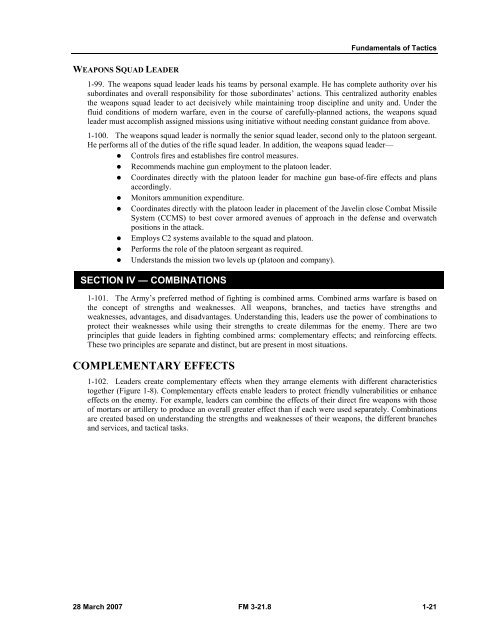Infantry Rifle Platoon and Squad - Sakai
Infantry Rifle Platoon and Squad - Sakai
Infantry Rifle Platoon and Squad - Sakai
Create successful ePaper yourself
Turn your PDF publications into a flip-book with our unique Google optimized e-Paper software.
Fundamentals of Tactics<br />
WEAPONS SQUAD LEADER<br />
1-99. The weapons squad leader leads his teams by personal example. He has complete authority over his<br />
subordinates <strong>and</strong> overall responsibility for those subordinates’ actions. This centralized authority enables<br />
the weapons squad leader to act decisively while maintaining troop discipline <strong>and</strong> unity <strong>and</strong>. Under the<br />
fluid conditions of modern warfare, even in the course of carefully-planned actions, the weapons squad<br />
leader must accomplish assigned missions using initiative without needing constant guidance from above.<br />
1-100. The weapons squad leader is normally the senior squad leader, second only to the platoon sergeant.<br />
He performs all of the duties of the rifle squad leader. In addition, the weapons squad leader—<br />
• Controls fires <strong>and</strong> establishes fire control measures.<br />
• Recommends machine gun employment to the platoon leader.<br />
• Coordinates directly with the platoon leader for machine gun base-of-fire effects <strong>and</strong> plans<br />
accordingly.<br />
• Monitors ammunition expenditure.<br />
• Coordinates directly with the platoon leader in placement of the Javelin close Combat Missile<br />
System (CCMS) to best cover armored avenues of approach in the defense <strong>and</strong> overwatch<br />
positions in the attack.<br />
• Employs C2 systems available to the squad <strong>and</strong> platoon.<br />
• Performs the role of the platoon sergeant as required.<br />
• Underst<strong>and</strong>s the mission two levels up (platoon <strong>and</strong> company).<br />
SECTION IV — COMBINATIONS<br />
1-101. The Army’s preferred method of fighting is combined arms. Combined arms warfare is based on<br />
the concept of strengths <strong>and</strong> weaknesses. All weapons, branches, <strong>and</strong> tactics have strengths <strong>and</strong><br />
weaknesses, advantages, <strong>and</strong> disadvantages. Underst<strong>and</strong>ing this, leaders use the power of combinations to<br />
protect their weaknesses while using their strengths to create dilemmas for the enemy. There are two<br />
principles that guide leaders in fighting combined arms: complementary effects; <strong>and</strong> reinforcing effects.<br />
These two principles are separate <strong>and</strong> distinct, but are present in most situations.<br />
COMPLEMENTARY EFFECTS<br />
1-102. Leaders create complementary effects when they arrange elements with different characteristics<br />
together (Figure 1-8). Complementary effects enable leaders to protect friendly vulnerabilities or enhance<br />
effects on the enemy. For example, leaders can combine the effects of their direct fire weapons with those<br />
of mortars or artillery to produce an overall greater effect than if each were used separately. Combinations<br />
are created based on underst<strong>and</strong>ing the strengths <strong>and</strong> weaknesses of their weapons, the different branches<br />
<strong>and</strong> services, <strong>and</strong> tactical tasks.<br />
28 March 2007 FM 3-21.8 1-21

















